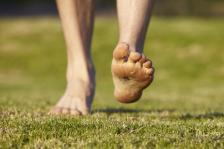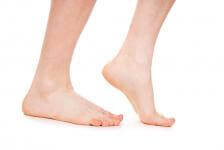Barefoot Running: Should You (and Your Kids) Take Off the Shoes?
Get-Fit Guy explains why barefoot running might be better than wearing shoes, when you should actually wear shoes, and whether kids should wear minimalist shoes or do barefoot running.

In this episode, you’re going to learn why barefoot running might be better than wearing shoes, when you should actually wear shoes, and whether kids should wear minimalist shoes or do barefoot running.
Sponsor: BrainHQ helps you think faster, focus better, and remember more – for whatever is important to you. Start training your brain today. Get 10% off your monthly or annual subscription at brainhq.com/getfit.
Is Barefoot Running Better Than Wearing Shoes?
So is barefoot running any better than running in shoes?
There are definitely 3 advantages to switching to minimalist footwear or barefoot running. This is because when you switch to minimalist approach you:
-
take shorter strides. Running with shorter strides and higher frequency naturally reduces the impact forces on your foot – which you tend to not worry about quite so much when you’re wearing shoes. Fortunately, shorter strides also mean less impact higher up in your ankles, knees, and hips! Likely due to these shorter strides, barefoot running has also been shown to lower heart rate and the rate of perceived exertion while increasing running efficiency.
-
land with a slightly flatter foot. When you’re running barefoot, your toes are not quite as “pointed towards the sky” and you don’t strike with your heel as much. This means that your heels and ankles undergo far less pressure and impact.
-
sense the ground beneath you better. The skin on the bottom of your foot (specifically the nerves called “proprioceptors”) can actually do a better job sensing the surface when you run barefoot. This can cause the tiny muscles in your foot to do a better job naturally absorbing shock and lowering impact.

Furthermore, if you are overweight, have poor running form, have a weak core or hips, or have spent your entire life wearing shoes for most activities, then shoes provide your feet with extra “muscle” and cushion to support the impact from landing. They also keep the foot from excessive movement or arch collapse when you’re running.
If you fall into these categories, then barefoot running may be very difficult to transition to, and could actually increase your risk for injury. In other words, I don’t think overweight, unfit people should choose barefoot running as their running mode of choice.
Should Kids Do Barefoot Running?
As I mentioned in the previous Barefoot Running episode, I rarely wear shoes in my regular life. And my kids have both followed suit. Like some kind of ancient tribesmen (or their own father) they have resilient, calloused, tough feet. They play outside, hike, run, stand, and move primarily barefoot or wearing Nike Frees.
The argument for letting your child go barefoot is that the shape and density of your kid’s bones is a direct result of the loads and geometry placed on their body. So this means that the way your child’s foot is loaded will affect the lifelong shape of their pelvis, their hips, their knees, their back, and even the space in their chest that their lungs are in!
This is why kids with poor posture grow up to be adults with poor posture. Kids who haven’t had their bones exposed to a variety of loads such as running or lifting and moving objects have been shown to have lower bone density later in life and to suffer from flat feet. Pediatric research is now showing that overprotective, stabilizing, modern footwear can interfere with the development of your kid’s foot strength, ankle stability, and movement patterns for the rest of their life. In other words, wearing super cushioned shoes can cause your child’s foot muscles to atrophy and foot bones to degrade.
Fortunately, this is all reversible. Of course, you just can’t reverse it in 2 weeks by buying Vibram Five Fingers, getting a stress fracture, then filing a lawsuit. It takes patience. Most of my clients need 1-2 years to make a full transition back to developing strong and natural feet if they’ve been wearing cushioned, overprotected shoes much of their life. And they do it by using these types of transitional strategies. But with kids, this remodeling happens faster. Kids can reshape and redevelop foot structure and bones within just 3 months.
So besides avoiding modern, built-up shoes, what else can you do to give your kids good, strong feet?
-
Choose children’s shoes that are super flexible or minimalist. Good brands include Vibram, Vivo Barefoot, Happy Little Soles, Bobux, Merrell, and Nike Free.
-
Play foot games with your kids to encourage motor skills and healthy foot development. For example, they can pick up marbles with their feet and put them into a cup.
-
Massage your child’s feet for a few minutes before bedtime.
-
Use Happy Feet Socks, which spread the toes and strengthens the feet. They’re great for adults too.
-
If you live near sand, let your kids run and walk in sand, which is one of the best ways to both strengthen and stretch the feet.
Between this episode and the last, you now know everything you need to know about barefoot running!
But if you have more questions about barefoot running and how to give it a try, you can leave your thoughts over at Facebook.com/GetFitGuy.
Child walking barefoot image courtesy of Shutterstock.








